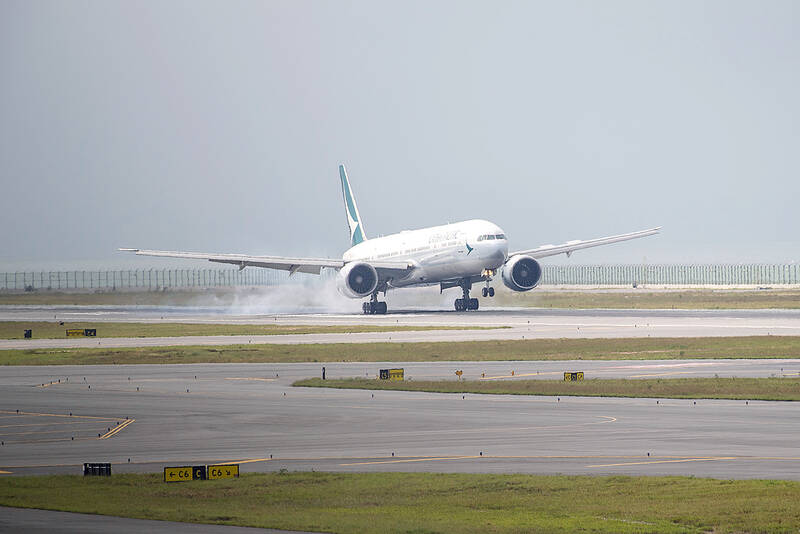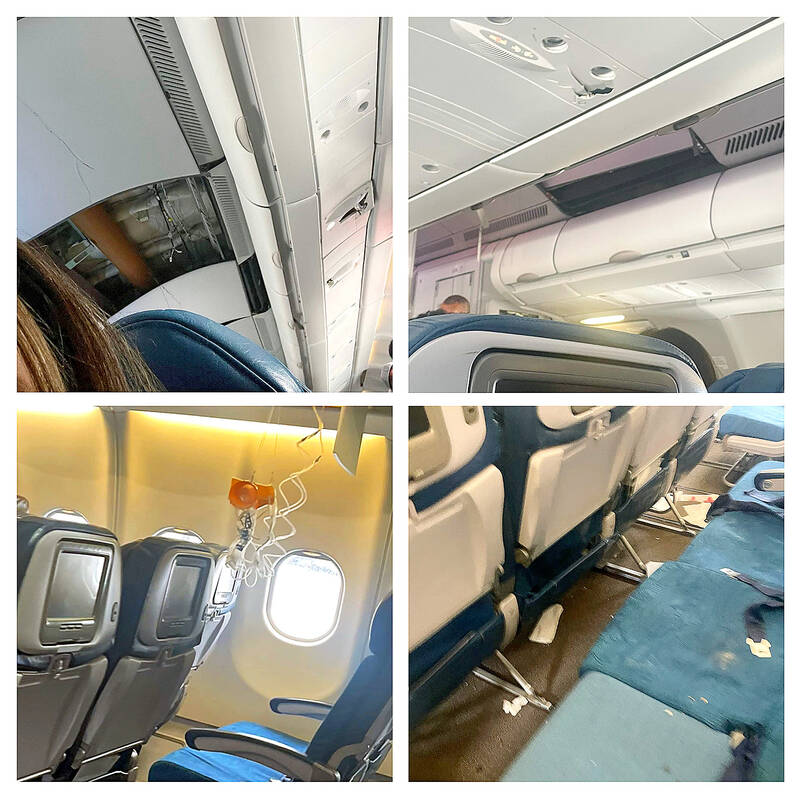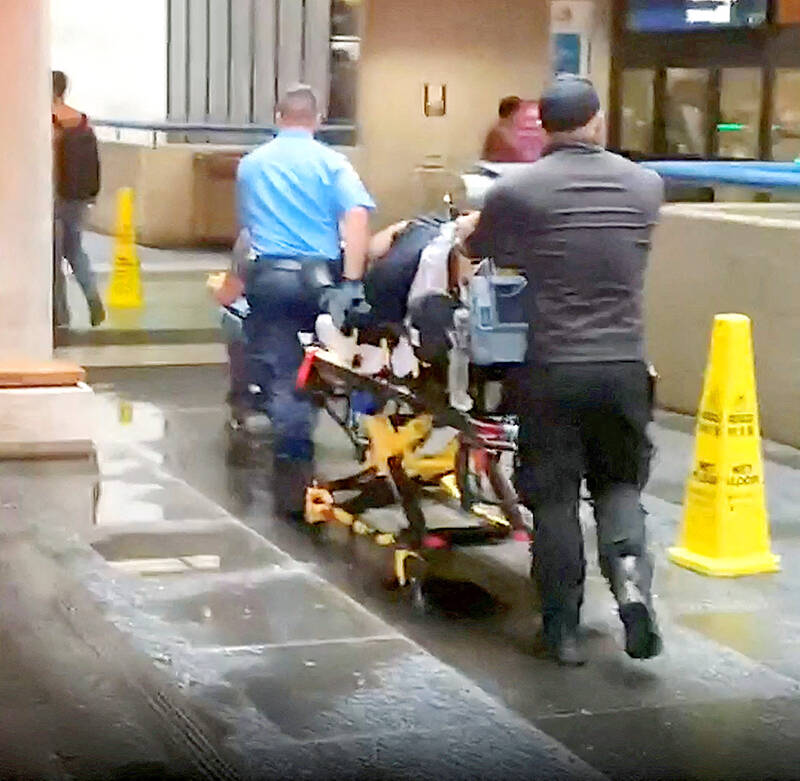The latest injuries from airplane turbulence were on flights to Honolulu and Houston, leading to a total of 41 people being hurt or receiving medical treatment in just two days — Sunday and Monday.
Back in July, severe turbulence led to at least eight minor injuries on a flight to Nashville, Tennessee, which had to be diverted to Alabama. Another three serious injuries to crew members were reported on three separate flights this year to Detroit, Miami and Columbus, Ohio, according to data from the National Transportation Safety Board.
US airlines have made steady improvements in their overall accident rate, but turbulence continues to be a major cause of accidents and injuries, according to a NTSB report last year. Turbulence accounted for 37.6 percent of all accidents on larger commercial airlines between 2009 and 2018.

Photo: AP
The Federal Aviation Administration also stated in a release Monday that there were 146 serious injuries from turbulence from 2009 to last year.
Climate change is expected to make turbulence worse in the coming decades, experts say. And while improvements in forecasting will help, not everyone expects the technology to ever be perfect.
In the meantime, the NSTB says that more can be done — both within the industry and among passengers. And everyone agrees that simply wearing a seatbelt during the entire flight will significantly reduce one’s risk of injury.

Photo: AP
WHAT IS TURBULENCE?
Turbulence is essentially unstable air that moves in a non-predictable fashion. Most people associate it with heavy storms. But the most dangerous type is clear-air turbulence, which can be hard to predict and often with no visible warning in the sky ahead.
Clear-air turbulence happens most often in or near the high-altitude rivers of air called jet streams. The culprit is wind shear, which is when two huge air masses close to each other move at different speeds. If the difference in speed is big enough, the atmosphere can’t handle the strain, and it breaks into turbulent patterns like eddies in water.

Photo: Reuters
“When those eddies are on the same scale as the aircraft, it causes one side of the aircraft to go up and one side to go down or causes the airplane to lose and gain altitude very quickly,” said Thomas Guinn, a meteorology professor at the Embry-Riddle Aeronautical University in Daytona Beach, Florida.
If pilots experience moderate turbulence, they can generally avoid it by flying to a higher altitude, Guinn said. But severe turbulence needs to be avoided all together.
“We can give kind of broad areas of where the turbulence is,” Guinn said. “If the indicators are for severe, then we generally expect pilots to to avoid those regions.”
WHAT ROLE DOES CLIMATE CHANGE PLAY?
Paul Williams, a professor of atmospheric science at the University of Reading in England, says global warming is changing temperature patterns in the upper atmosphere. And that is causing more instability in the jet streams.
“More specifically, at flight-cruising altitudes, the tropics are warming more rapidly than the poles ... leading to stronger north-south temperature differences across the jet stream, and it is those temperature differences that drive the wind shear,” Williams wrote in an e-mail.
But the implications for air travelers are still not fully known, he cautioned.
“One could argue that pilots should be getting better at avoiding turbulence over time, because the specialized forecasts that are used to seek out smooth routes are gradually improving,” Williams wrote. “So more turbulence in the atmosphere will not necessarily translate into more injuries.”
HOW COMMON ARE TURBULENCE-RELATED INJURIES?
The NTSB’s report last year showed that there were 111 turbulence-related accidents between 2009 and 2018 that resulted in at least one serious injury. That figure applies to commercial carrier planes with more than nine passenger seats.
“Most passengers seriously injured ... are either out of their seats or seated with their seat belts unfastened,” the report said.
Flight attendants — who are often up and moving — were most commonly hurt, accounting for 78.9 percent of those seriously injured.
Numbers released Monday by the FAA showed a similar breakdown between 2009 and last year: 116 of the 146 serious turbulence injuries — or 79 percent — were among crew.
Accident reports filed with the NTSB provide examples. For instance, turbulence on a flight from Dallas-Fort Worth to Miami in July last year resulted in a flight attendant “striking the floor hard” in the aft galley and being diagnosed with “a fractured compressed vertebra.”
On another flight from San Antonio to Chicago in August of last year, a flight attendant “had fallen to her knees because of the turbulence” and “was diagnosed with a fractured kneecap.” And on a flight from Baltimore to Atlanta in October last year, a flight attendant fell and broke her ankle during drink service when the plane “unexpectedly entered a cloud and experienced moderate to borderline severe turbulence.”
“When turbulence occurs, it can be severe and lead to significant, very serious injuries: everything from broken bones to spinal issues to neck issues,” NTSB Chair Jennifer Homendy said in an interview.
WHAT CAN BE DONE?
The NTSB’s report last year offered a long list of recommendations. They included more information-sharing among pilots, carriers and air traffic controllers regarding the weather and turbulence incidents.
“We want to make sure that the best suite of technologies is used ... to provide the best information to pilots and flight attendants and passengers,” Homendy said.
The agency also urged revisions to safety recommendations regarding when flight attendants should be secured in their seats, including portions of descent, which would “reduce the rate of flight attendant injuries.”
The report also cited parents who have been unable to hold infants securely on their laps during turbulence. The NTSB stated that it’s safest for children under the age of two to be in their own seat and using an appropriate child restraint system.
Michael Canders, director of the Aviation Center at Farmingdale State College in New York, said many in the industry are already sharing information with each other regarding turbulence, while forecasting has improved over the years.
But he’s unconvinced that it will ever be perfect.
“There’s this argument or debate about, ‘Will technology save us or do we need to back off and take better care of the earth?’ ” said Canders, who is also an associate professor of aviation. “I think we have to do both.”
Canders added that preventing injuries from turbulence is “best addressed by sitting in your seat and seat-belting in.”

Seven hundred job applications. One interview. Marco Mascaro arrived in Taiwan last year with a PhD in engineering physics and years of experience at a European research center. He thought his Gold Card would guarantee him a foothold in Taiwan’s job market. “It’s marketed as if Taiwan really needs you,” the 33-year-old Italian says. “The reality is that companies here don’t really need us.” The Employment Gold Card was designed to fix Taiwan’s labor shortage by offering foreign professionals a combined resident visa and open work permit valid for three years. But for many, like Mascaro, the welcome mat ends at the door. A

Divadlo feels like your warm neighborhood slice of home — even if you’ve only ever spent a few days in Prague, like myself. A projector is screening retro animations by Czech director Karel Zeman, the shelves are lined with books and vinyl, and the owner will sit with you to share stories over a glass of pear brandy. The food is also fantastic, not just a new cultural experience but filled with nostalgia, recipes from home and laden with soul-warming carbs, perfect as the weather turns chilly. A Prague native, Kaio Picha has been in Taipei for 13 years and

The Western media once again enthusiastically forwarded Beijing’s talking points on Japanese Prime Minister Sanae Takaichi’s comment two weeks ago that an attack by the People’s Republic of China (PRC) on Taiwan was an existential threat to Japan and would trigger Japanese military intervention in defense of Taiwan. The predictable reach for clickbait meant that a string of teachable moments was lost, “like tears in the rain.” Again. The Economist led the way, assigning the blame to the victim. “Takaichi Sanae was bound to rile China sooner rather than later,” the magazine asserted. It then explained: “Japan’s new prime minister is

Since Cheng Li-wun (鄭麗文) was elected Chinese Nationalist Party (KMT) chair on Oct. 18, she has become a polarizing figure. Her supporters see her as a firebrand critic of the ruling Democratic Progressive Party (DPP), while others, including some in her own party, have charged that she is Chinese President Xi Jinping’s (習近平) preferred candidate and that her election was possibly supported by the Chinese Communist Party’s (CPP) unit for political warfare and international influence, the “united front.” Indeed, Xi quickly congratulated Cheng upon her election. The 55-year-old former lawmaker and ex-talk show host, who was sworn in on Nov.